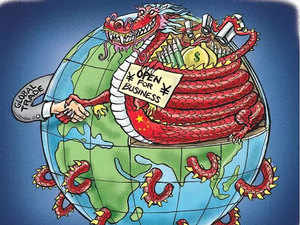Free trade: The China syndrome: While the world is being Sinified, the resistance is gathering force too

A Sinified world (dis)order won’t be good for India. A rules based democratic order would work much better.

COVID-19 CASES
WorldIndiaConfirmed380,532Deaths12,573Confirmed8,488,977Deaths453,987The coronavirus pandemic has highlighted the problem of transparency, and what China’s lack of it means for the global order. But that problem has already been there in spades, ever since the West made a Faustian bargain by admitting Communist China into the global trading order.
Global markets can only function with a modicum of transparency, and free markets require limited government. Communist China has none of those attributes. Yet it was admitted into the global trading system on the mistaken premise that it would gradually acquire them. With China’s subsequent – and stunning – rise to become the world’s second biggest economy, the postwar liberal order has been imploded from within and lies in ruins, contributing to the great world disorder we see today. Egregious Chinese behaviour on Ladakh’s icy heights is just one of the symptoms of that disorder.
There’s no doubt that Chinese firms are ferociously competitive, and their government has done an excellent job of developing infrastructure and tech prowess. But alongside Beijing has developed an extensive panoply of mercantilist, beggar-thy-neighbour policies that go against the spirit, if not the letter, of the principles of free trade and pursuit of competitive advantage that WTO is supposed to underpin.
These include currency manipulation, standards manipulation, a comprehensive system of state subsidies for national firms, repressing returns on household savings through an underdeveloped financial sector, forced technology transfers, forced joint ventures, technology theft including through cyber-espionage, limiting exports of critical materials to deny key inputs to foreign firms, the weaponisation of trade for political ends.
India has been a particular victim of Chinese mercantilism. Opaque Chinese authorities permit imports of few Indian goods and services that have otherwise been globally competitive, thus perpetuating an exploitative, colonial-style trade relationship with India. And now, of course, Indian soldiers have been brutally killed.
Supporting China’s mercantilist methods is a political system of all encompassing surveillance and suppression of dissent using state of the art digital technology, a system that has been described as ‘digital Leninism’ and reaches Orwellian proportions. Political liberalism supports economic liberalism – following a rules-based global order has something to do with being able to implement the rule of law and separation of powers at home. But the Chinese system is the very antithesis of political liberalism.
President Xi Jinping has made no bones about the ‘Make China Great Again’ campaign, by any means possible. But the very success of the Chinese mercantilist model dictates its failure. Wins for China became losses for other economies, sparking populist revolts in the West. Mercantilism becomes a lose-lose game when other countries too adopt it. Famously, the US veered towards mercantilism with the election of President Donald Trump. The Chinese model of populist nationalism is now everywhere, placing the WTO trading system on its last legs. A ‘Nationalist International’ is an oxymoron.
The politically authoritarian side of the Chinese model has also enjoyed unprecedented success. Trump makes his admiration for ‘strongmen’ evident, and regularly disses the democratic leaders of traditional US allies. Domestically, he has few words of condemnation for police violence against blacks, but threatens to call out the military in response to civilian demonstrations and riots protesting police brutality.
However, a liberal pushback against populist nationalism is also underway. US presidents generally win a second term but Trump could prove an exception this November – current opinion polls show him behind Democratic candidate Joe Biden by large margins. George Floyd is an international cause celebre, with protests against his killing having spread to every continent. India witnessed widespread youth protests against the opaque, discriminatory and statist CAA-NRC combo. New internationalist coalitions are forming, such as the Inter-Parliamentary Alliance on China between lawmakers from eight countries, which will deliberate on how democracies can work together to support a “free, open and rules-based international order”.
Chinese soft power in India is immense, with the China model drawing admiration from both the political right and left. However, India is bumping up against the realities of Chinese hard power on the LAC – which should inspire a rethink. That Indian soldiers were killed after an agreement to disengage in Galwan valley, is another illustration of Chinese opacity and unwillingness to stick by agreements or rules. The rogue superstate that gave the world coronavirus speaks only the language of deception and brute force.
Indeed Beijing has backtracked from its commitment, under the Border Peace and Tranquility Agreement of 1993, to exchange maps that would clarify where the LAC stands. Keeping its claims ambiguous is a way of keeping India on the hop, so that New Delhi walks on eggshells when it comes to Chinese interests while Beijing feels free to drive a coach and horses through Indian interests.
A Sinified world (dis)order won’t be good for India. A rules based democratic order would work much better. If the world is being Sinified then the resistance is gathering force too, and India should join the resistance. Given that trade is weaponised these days it should look to form trade as well as security alliances with friendly countries. Staying out of RCEP was the right decision.
China did very well out of the last Cold War, as I argued in these columns recently. But India can do well from the coming one.
DISCLAIMER : Views expressed above are the author’s own.
Source: indiatimes.com

